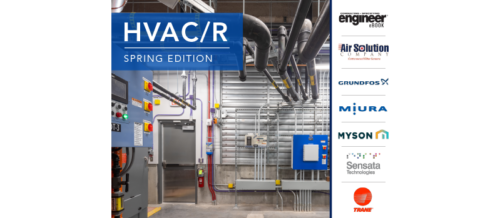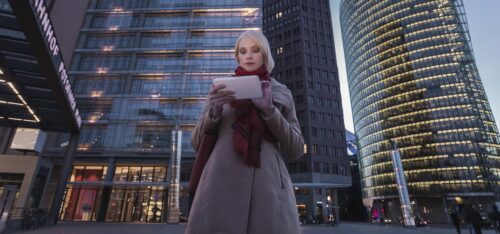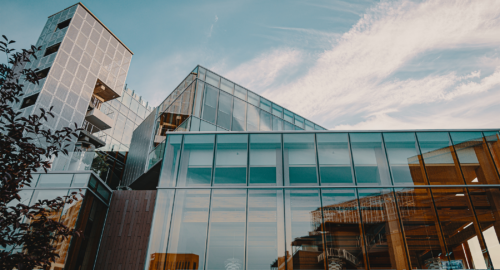Warehouse, manufacturing facilities go high-tech: HVAC
Warehouse, manufacturing and logistics buildings are more than simple boxy structures used to make products and store them before they move onto their next destination. HVAC and plumbing systems are complex, and require specialized design
Respondents
Leonard Belliveau Jr., PE, SET, vice president, strategic accounts, Jensen Hughes, Framingham, Mass.: Belliveau has more than 22 years of experience managing fire protection engineering design and code consulting on government and commercial projects. Clients include a large shipping company, U.S. Department of Transportation and Leidos Corp.
Jason R. Gerke, PE, CxA, LEED AP BD+C, practice area leader – Mechanical/Plumbing | Principal, GRAEF, Milwaukee.: As a practice area leader, Gerke has worked on a broad range of projects, including convention centers, schools, airports and others. He has more than 12 years of mechanical design, commissioning and project management experience.
George D. Halkias, AIA, LEED AP, NCARB, senior principal, Stantec, Pittsburgh: Serving as senior principal, Halkias brings more than 20 years of experience — as well as knowledge on a wide range of project types — to the company. He has designed, consulted on or managed more than 2 million square feet of U.S. Green Building Council LEED certified buildings.
Josh Meinig, PE, senior mechanical engineer, CDM Smith, Maitland, Fla.: Meinig is the lead mechanical engineer in the southeast region at CDM Smith. He has more than 14 years of experience in mechanical design and construction services for environmental, industrial, military and commercial facilities.
Doug Sandridge, PE, principal, RTM Engineering Consultants, Wheat Ridge, Colo.: Sandridge, principal, comes to RTM from Concord West, an engineering firm specializing in design, construction and management services that the firm acquired in June. His portfolio includes a number of liquor distilleries and international projects.
CSE: What unique cooling systems have you specified into such projects? Describe a difficult climate in which you designed an HVAC system for a warehouse, manufacturing or logistics facility.
Sandridge: For colder climates, we see more high heat applications for makeup air units versus traditional gas-fired unit heaters. This trend not only saves on energy but produces air changes for storage warehouses and increases ventilation for manufacturing areas. In colder or higher altitude climates, we can look at refrigeration economizers for cold-storage facilities. In warmer and humid climates, special considerations are required for refrigeration systems, especially if a transcritical carbon dioxide or adiabatic application is being considered.
Meinig: For a project in Phoenix, evaporative cooling was implemented for the manufacturing floor. Few climates can support evaporative cooling for thermal comfort.
CSE: What unusual or infrequently specified products or systems did you use to meet challenging cooling needs?
Meinig: Evaporative cooling. These products have a climate/geographic limitation but are very good for conserving energy.
Sandridge: For food process facilities under USDA requirements, prevention of condensation on surfaces in the process areas can be a significant challenge. The use of dehumidification equipment or special hygienic air handling equipment may be required and are becoming more commonplace.
CSE: How have you worked with HVAC system or equipment design to increase a building’s energy efficiency?
Halkias: As opposed to traditional warehouse spaces, fulfillment centers have the added requirement for air conditioning. This change in requirements have pushed energy usage and electrical loads much higher. The warehouse areas are only maintained at a design temperature of 85°F, with the supply airflow coming from the exterior walls pushing across the workers then toward the center of the warehouse. This allows evaporative type cooling for the workers allowing the space temperature to be higher, thus saving energy from a typical 75°F space.
Meinig: I have used energy recovery for these types of facilities. Capturing waste energy or ventilated energy through heat exchangers or desiccant wheels to lower the overall energy consumption of the facility.
Sandridge: We use energy modeling to generate comparisons in energy use and develop pay back scenarios for owners to make good business decisions.
CSE: Describe a manufacturing project in which process piping was required. What were the challenges and solutions?
Meinig: Finding adequate space and allowing for future expansions is always challenging. Using pipe trestles is a good way to manage the process piping in a facility. In a recent project, I used a pipe trestle system for cooling water (supply and return), natural gas, water, nitrogen and deionized water for the manufacturing process.
Sandridge: The two most common challenges are material selection for cost savings and finding qualified contractors in remote work areas. When possible, we will evaluate different piping materials to ensure the most cost-effective solution. Also, we prepare full piping and instrumentation drawings to effectively convey the requirements to the construction team.
We also issue process piping specifications, so a contactor can be confident in meeting the project requirements, before bidding. Another consideration is how will the piping be cleaned out or what will be needed to prevent product cross contamination. In addition to industry standard cast-iron pipe solutions, we have designed launch systems using compressed air to clean out process piping.
CSE: What best practices should be followed to ensure an efficient HVAC system is designed for this kind of building?
Gerke: Best practices for design of manufacturing buildings should include energy modeling to ensure realistic energy targets are set early in the project. Once energy goals are established and coordinated with the owner’s project requirements, equipment selection can take place. Evaluation of available HVAC equipment needs to consider if a competitive bidding process is required and if sole sourcing a specific manufacturer is allowed. No matter the situation, design professionals must review the available options for equipment and make decisions about which features are required for a successful project. Unfortunately, these decisions are sometimes driven by first cost concerns, but tools such as energy modeling are able to provide additional information, so the owner is able to make an informed decision.
Meinig: Following applicable codes and standards and using easy to maintain and procure equipment is the best way to ensure the owner sustains with the designed system.
CSE: What are some of the challenges or issues when designing for water use in such facilities?
Sandridge: Water use helps determine a lot more than just the size of the water service. The city will use this data to evaluate sanitary sewer requirements, including interceptors, test ports or even metering. Determining water use for and industrial or process application is far from exact, as there are many factors that contribute.
For example, estimating how much water will be used during clean up or the sanitation cycle. RTM will develop water management strategies and identify potential diversities for times of water use to minimize the water service and water tap as well as pipe sizing. In some cases, we have actually recalculated the water use data published by an OEM to achieve a more realistic water use rate for the process equipment.
Halkias: Due to the increasing footprints for ecommerce facilities, designing for the long runs of piping for domestic cold water, sanitary sewer and domestic hot water return systems to meet the codes is an added challenge for this building type.
Meinig: Quite a few of the facilities are in remote areas where water and sanitary mains do not exist. To limit septic design and well size, water recycling and reuse is often implemented.
CSE: What types of specialty gases or other similar materials have you specified into a manufacturing facility? Describe the project and its results.
Meinig: I have specified nitrogen generators and nitrogen piping for the manufacturing process. I have also specified liquid oxygen and liquid carbon dioxide piping for a similar project.
Sandridge: Specialty gases include nitrogen for cryogenic applications and carbon dioxide for cooling or motive function. In both cases, increased ventilation and monitoring are required to protect workers from a potential leak. Oxygen and hydrogen have the added fire risks associated with their use. Other gases like ammonia require compliance with OSHA and EPA regulations.
CSE: Describe a facility in which there were specialty air movement requirements, such as unique air pressure needs or high-velocity low-speed fans.
Gerke: A recent manufacturing project designed by GRAEF included the use of weld filtration equipment throughout areas of the building. The weld filtration system required airflow to be in a specific pattern to capture weld smoke and direct it toward the filtration equipment installed in the space. Special consideration was required to determine the optimal location of supply air in the space as maximum and minimum space temperature requirements were in place. Close coordination with the weld fume filtration vendor and the HVAC system design resulted in an HVAC system that provided occupant comfort and weld filtration system that provided the required filtration.
Meinig: To save on comfort cooling and hating cost, I have specified high-velocity low-speed fans throughout the United States. Careful coordination with lighting and skylights must be taken along with any monorails or bridge cranes.
Do you have experience and expertise with the topics mentioned in this content? You should consider contributing to our CFE Media editorial team and getting the recognition you and your company deserve. Click here to start this process.





